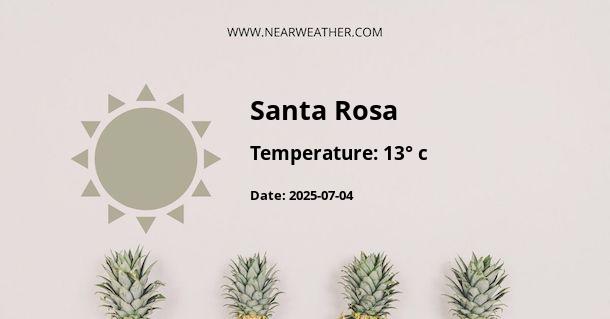Santa Rosa, Bolivia: Climate and Weather Overview
Santa Rosa is a beautiful city located in the eastern lowlands of Bolivia, known for its lush greenery, diverse wildlife, and vibrant culture. Understanding the climate and weather patterns of Santa Rosa is crucial for residents, tourists, and businesses operating in the region. Let's explore the year-round climate and weather conditions in Santa Rosa to gain a comprehensive understanding of what to expect when visiting or living in this picturesque city.
Climate Classification
Santa Rosa falls under the tropical savanna climate classification, also known as Aw, according to the Köppen-Geiger climate classification system. This classification indicates that the city experiences distinct wet and dry seasons throughout the year.
Temperature
The temperatures in Santa Rosa remain relatively warm and consistent year-round. The average annual temperature is around 25°C (77°F). The hottest months are typically from September to November, with temperatures reaching highs of 32°C (90°F) or more. In contrast, the coolest months occur from May to July, with average lows of 20°C (68°F).
The following table illustrates the average monthly temperatures in Santa Rosa:
| Month | Average Temperature (°C) | Average Temperature (°F) |
|---|---|---|
| January | 26 | 79 |
| February | 26 | 79 |
| March | 26 | 79 |
| April | 25 | 77 |
| May | 24 | 75 |
| June | 23 | 73 |
| July | 23 | 73 |
| August | 24 | 75 |
| September | 26 | 79 |
| October | 27 | 81 |
| November | 27 | 81 |
| December | 26 | 79 |
Rainfall
Santa Rosa experiences a distinct wet season and dry season. The wet season typically occurs from November to March, with December and January being the wettest months. During this period, the city receives abundant rainfall, contributing to the region's lush vegetation and vibrant ecosystem. On the other hand, the dry season spans from May to August, with significantly reduced precipitation.
The following chart illustrates the average monthly rainfall in Santa Rosa:

Humidity
The humidity levels in Santa Rosa remain relatively high throughout the year, especially during the wet season. Humidity levels can reach as high as 80-90% during the peak of the rainy season, creating a humid and tropical atmosphere. In contrast, humidity levels decrease during the dry season, offering a slightly drier and more comfortable environment.
Extreme Weather Events
While Santa Rosa generally experiences mild and consistent weather patterns, the region is susceptible to occasional extreme weather events such as tropical storms and heavy rainfall. These events can lead to localized flooding and infrastructure challenges. It is essential for residents and visitors to stay informed about weather forecasts and heed any warnings issued by local authorities during such occurrences.
Conclusion
In conclusion, Santa Rosa's tropical savanna climate brings warm temperatures, distinct wet and dry seasons, and ample rainfall, contributing to the city's lush environment and rich biodiversity. Understanding the climate and weather patterns is essential for anyone considering a visit or long-term stay in this vibrant Bolivian city.
By being aware of the seasonal variations and weather characteristics, individuals can better prepare for their Santa Rosa experience and fully appreciate the natural beauty and unique climate that the city has to offer.
A - Santa Rosa's Latitude is -14.166670 & Longitude is -66.883331.
A - Weather in Santa Rosa is 23° today.
A - Climate Conditions in Santa Rosa shows light rain today.
A - Humidity in Santa Rosa is 99% today.
A - Wind speed in Santa Rosa is 10.01 km/h, flowing at 127° wind direction. today.
